1. Welcome!
The video below sets the stage for all of the learning you’ll be doing in your AP Biology course this year. For convenience, and if it suits your learning style, I’ve also provided a loose (not word-for-word) transcript of the video. After you’re done watching the video, practice what you’ve learned through the flashcards and quiz that follow the text transcript.
2. Video: Biology’s 4 Big Ideas
3. Text Version: Biology’s Four Big Ideas
Note: this text transcript is for your reference. Whenever you’re ready, jump down to the flashcards and quiz that follow
Welcome to Episode One of Thinking Biologically: Biology’s Four Big Ideas.
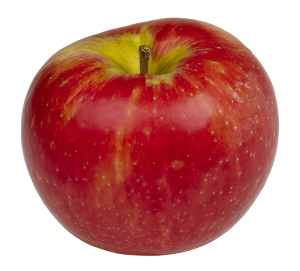
These ideas were developed by the College Board, and they serve as an intellectual scaffold that you can use to organize all of the information in this very information-rich subject. Here’s what they are:
- Evolution,
- Information storage and transmission,
- Energy and matter flow, and
- Systems and system interactions.
And they’re all right here in this apple.
Idea # 1: Evolution
Evolution is the process by which living things change over time. This apple is a Gala (or a Gāla, depending on how you like to pronounce it). It’s a cultivated variety of a wild undomesticated apple that first evolved in Central Asia. If you could go back in time a few hundred years you wouldn’t find a Gala apple. That’s because this variety has only been cultivated for about a hundred years. It’s one of the hundreds of apple varieties, each with different appearances and tastes, that humans have created through selective breeding.
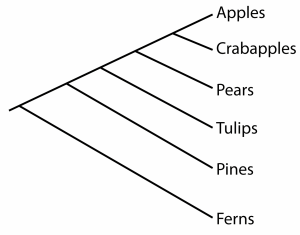
Evolution is a process that unfolds over time. You can use a diagram like this — called a phylogenetic tree — to represent the evolutionary history of any organism, including apples. Apples have a common relatively recent ancestor with crab apples. They’re more distantly related to fruit such as pears. Apples, crab apples, and pears are part of an enormous group of species called the flowering plants that first emerged over a hundred million years ago in the time of the dinosaurs. A more ancient ancestor gave rise to plants with seeds but no flowers (like pine trees) about 350 million years ago. You can push further back to seedless plants (like ferns), and eventually, you reach an ancestor that wasn’t a plant at all. Before 450 million years ago there was no life on land. There were no plants. At that point, the apple’s ancestor was some kind of aquatic photosynthetic algae.
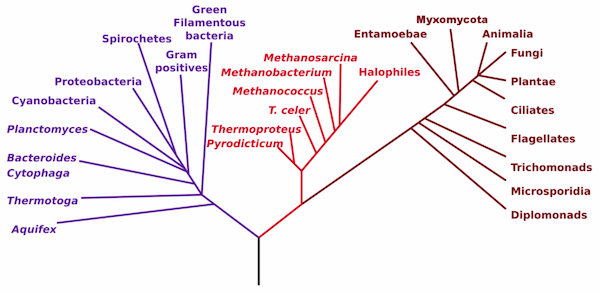
It’s possible to create a phylogenetic tree that covers all of evolutionary history — essentially the tree of life. On the upper right side of the diagram, you can find the Plant Kingdom (Plantae), the group to which apples belong. A bit above that and slightly to the left is our kingdom, Animalia (the animal kingdom). Note that we and apples have an ancestor in common. The apple is our evolutionary cousin, as is every other living thing. Is there evidence for that astounding claim? Of course: it’s embedded in our genes, our cellular structure, and our metabolism. We’ll present the evidence for that later in this course.
Evolution produces adaptations: structures with functions that help organisms survive and reproduce. The skin of this apple is an adaptation that evolved to attract animals by letting the apple be seen against a sea of green leaves. That’s a trait that co-evolved with color vision in fruit-loving primates like ourselves. The apple’s skin also protects the apple’s flesh from bacteria and fungi. The flesh is an adaptation that evolved to be a reward for animals that would eat the fruit and swallow the seeds. The seeds themselves have other adaptations including a protective seed coat that allows the seeds to pass through an animal’s gut without being broken down by the acids in an animal’s stomach. This allows the seeds to be deposited somewhere where they can grow into new apple trees.
Adaptations come about through a process called natural selection. In any population, there’s variation in traits. Among the apple seeds, there are going to be some that have thicker coats and some that have thinner coats. Some of that variation is determined by genes. Variants that are unsuccessful — which means that they’re not very good at promoting survival and reproduction — are going to wind up being removed from the population. An apple seed that has a coat that’s too thin is going to wind up being dissolved in the stomach as it’s being dissolved. The genes for that trait are also going to be dissolved. That means that those genes won’t wind up being represented in the next generation’s gene pool. The opposite is going to happen to traits that are more adaptive (that help an organism to survive and reproduce). So over time, natural selection shapes adaptations. It’s that simple.
Idea # 2: Information Storage and Transmission
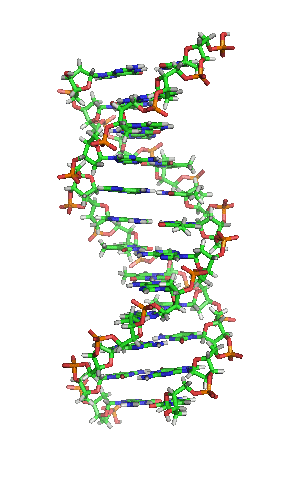
The second big idea in our course is information storage and transmission. Again, think about this apple. You plant an apple seed, and you get a new plant. What the seed is transmitting is information about how to build a new tree. That information is genetic information and it’s stored in a molecule called DNA.
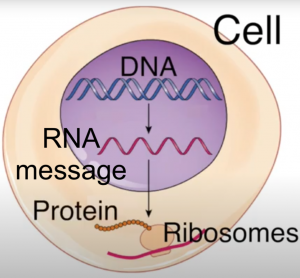
Let’s think about DNA in the context of a cell. DNA is in the cell’s nucleus and it sends a message that goes to particles that are called ribosomes. Those ribosomes are unbelievable: what they can do is they can take information sent by DNA and translate it into protein. Protein determines the characteristics of cells. And in fact, through many complex mechanisms, proteins will wind up determining the characteristics of the entire organism. And that information has been changing over evolutionary time. In fact, you can think of evolution as a change in the genetic information carried within a population’s gene pool.
Idea # 3: Energy and Matter Flow
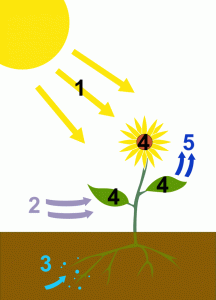
The third theme is energy and matter flow. This apple was built by cells using solar energy. Photosynthesis is one of the great energy reactions of living things. What photosynthetic cells can do is take free energy in sunlight (free energy is available energy that can be harvested to do work) and they use that energy to combine carbon dioxide (a gas in the air) and water to create carbohydrates. Those carbohydrates are full of chemical energy that plants can use to power their own life processes. These carbohydrates also provide the matter — the carbon, hydrogen, and oxygen atoms— that plants use to build themselves. Once captured by plants, that energy can pass to animals like you and me. What we animals do is to we take chemical energy and combine it with oxygen, releasing the energy we need to sustain our life processes. We breathe out the exhaust: carbon dioxide and water vapor. The entire process is called cellular respiration. It’s performed by plants, too, and it’s life’s other great energy-related process.
So we have energy flow from the sun into plants and then into animals like you and me. Note that this is a one-way flow. The energy isn’t lost, but it starts out as useful energy that can be harnessed for work, and by the time living things are done with it, it’s useless heat. Energy flows through living things and then dissipates. In almost every ecosystem on Earth, life is sustained by a constant flow of energy from the Sun.

Matter works differently: it’s recycled. Carbon, for example, will move from carbon dioxide in the air into plants like apple trees. Plants, in addition to doing photosynthesis, also do cellular respiration and that returns some carbon dioxide into the air. The carbohydrates made by plants can then pass to animals. We perform cellular respiration and that again returns CO2 to the air. When living things die they’re decomposed by bacteria and fungi. Decomposition returns carbon dioxide to the atmosphere, so the same atoms have been cycling on planet Earth for billions of years.
Idea # 4: Interacting Systems
Idea number four is that life is composed of complex interacting systems. A system is a group of connected things that form a larger whole. You know that phrase “the whole is greater than the sum of its parts?” That’s what systems are all about.
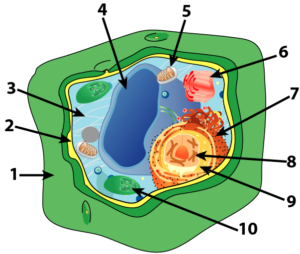
The systems that we’ll look at most in this course are cells, the building blocks of life. Earlier we looked at the Tree of Life. You can see here that the tree has a common stem and then there are three major branches. Each branch is a Domain. That’s the biggest classification category and it’s based on cell type. Simpler, smaller cells are found in bacteria and archaea. Much more complex cells, like the one in this Paramecium, are found in our Domain, the eukaryotes. Apple trees are composed of eukaryotic cells that are like the one shown on the left. These cells interconnect to form tissues like the photosynthetic tissue in a leaf. Interacting tissues form organs like the leaf itself.
At every level, new properties emerge as the system grows more complex. Organisms, whether they’re made of one cell like a Paramecium or trillions of cells like you and me, are open systems. That means that they have input and outputs. The inputs in terms of cellular respiration are things like fuel food and oxygen. The outputs are things like carbon dioxide, water, and other wastes.
Systems interact. When I took a bite out of this apple that was one organism consuming another organism. That’s an important kind of interaction. Living systems are also embedded within other systems. An apple tree, for example, is part of a wider ecosystem composed of interacting populations and the nonliving matter and energy that sustain them. All ecosystems are part of the biosphere, the living system that includes all life on Earth.
4. Checking Understanding: Biology’s Four Big Ideas
How are you going to learn this? You’ve got to interact with this information in order to learn it. Study the flashcards and complete the quiz below. DON’T WORRY ABOUT GETTING THIS RIGHT THE FIRST TIME. You can take as much time as you need until you can correctly respond to the prompts in the flashcards and quizzes with accuracy and confidence.
Most of the questions in the flashcards and quiz come directly from the video above. But some don’t. Use the flashcards and quiz as an opportunity to learn this material, which will give you a foundation for all the learning you’ll do this year.
Start with these flashcards
[qdeck random = “false” dataset=”Module_1_Flashcards” qrecord_id=”sciencemusicvideosmeister1961-Module_1_Flashcards (M1)”]
[h]Module 1: Themes/Big Ideas
[i]Instructions
Look at the question. Say the answer out loud.
Click “Check Answer.”
If you get it right, click “Got it”
If you need more practice, click “need more practice!”
Keep working until you’ve mastered all the cards.
[!!!!]++card :record #A2207+++[/!!!!]
[q json=”true” unit = “U1: Course Themes; Evolution and Natural Selection” topic = “M1: Key Themes Of Biology” dataset_id=”Module_1_Flashcards|169fe4207dbc9b” question_number=”1″]Define biology.
Note that this wasn’t really covered in the video but you have to learn this at some point!
[a]Biology is the science of life.
[!!!!]+++end of card data +++[/!!!!]
[!!!!]++card :record #A2208+++[/!!!!]
[q json=”true” unit = “U1: Course Themes; Evolution and Natural Selection” topic = “M1: Key Themes Of Biology” dataset_id=”Module_1_Flashcards|169fccd806d49b” question_number=”2″]What are the four key themes of biology?
[a]* Evolution
* Information Flow
* Matter and Energy Flow
* Systems (and system interactions)
[!!!!]+++end of card data +++[/!!!!]
[!!!!]++card :record #A2209+++[/!!!!]
[q json=”true” unit = “U1: Course Themes; Evolution and Natural Selection” topic = “M1: Key Themes Of Biology” dataset_id=”Module_1_Flashcards|169f974af5589b” question_number=”3″]Define evolution.
[a]Evolution is the process by which living things change over time.
[!!!!]+++end of card data +++[/!!!!]
[q json=”true” dataset_id=”Module_1_Flashcards|169f84aa96389b” question_number=”4″]What’s the name for a diagram like the one below that represents the evolutionary history of an organism?
[a]A phylogenetic tree
[!!!!]++card :record #A2210+++[/!!!!]
[q json=”true” unit = “U1: Course Themes; Evolution and Natural Selection” topic = “M1: Key Themes Of Biology” dataset_id=”Module_1_Flashcards|169f6d621f509b” question_number=”5″]DNA stores what kind of information?
[a]DNA stores genetic information.
[q json=”true” unit = “U1: Course Themes; Evolution and Natural Selection” topic = “M1: Key Themes Of Biology” dataset_id=”Module_1_Flashcards|169f586db44c9b” question_number=”6″]What are adaptations?
[a]Adaptations are structures or behaviors that increase an organism’s chance of surviving and/or reproducing.
[!!!!]+++end of card data +++[/!!!!]
[!!!!]++card :record #A2213+++[/!!!!]
[q json=”true” unit = “U1: Course Themes; Evolution and Natural Selection” topic = “M1: Key Themes Of Biology” dataset_id=”Module_1_Flashcards|169f41253d649b” question_number=”7″]Briefly describe how natural selection generates adaptations.
[a]At this point in our course, you should be able to explain natural selection as follows:
1) All populations have inherited (genetic) variations.
2) Variations that are unsuccessful (coding for poorly adapted traits) will be removed from a population, also removing the genes for those variations.
3) Genes for variations that are successful (coding for well-adapted traits) will be passed on to the next generation.
4) Repetition of this process over multiple generations in the same direction leads populations to become better adapted over time.
[q json=”true” dataset_id=”Module_1_Flashcards|169f2c30d2609b” question_number=”8″]Using this diagram, describe the flow in information within cells.
[a]Genetic information, stored as DNA, gets sent to ribosomes. Ribosomes translate the message into proteins, which determine the characteristics of cells and entire organisms.
[!!!!]+++end of card data +++[/!!!!]
[q json=”true” dataset_id=”Module_1_Flashcards|169f14e85b789b” question_number=”9″]Use this diagram to describe the flow of matter involved in photosynthesis.
[a]Photosynthesis is powered by light (1). During photosynthesis, water (3) is combined with carbon dioxide (2) to create the carbohydrates that make up the plant (4). Oxygen (5) is released as a waste product.
[q json=”true” dataset_id=”Module_1_Flashcards|169efff3f0749b” question_number=”10″]What happens during cellular respiration?
[a]During cellular respiration, organisms take the chemical energy in carbohydrates and combine it with oxygen. This gives organisms energy that they can use to power their life processes. Carbon dioxide and water vapor are released as waste products.
[q json=”true” dataset_id=”Module_1_Flashcards|169ee6576da89b” question_number=”11″]The way that energy and matter flow through the living world is quite different. Explain.
[a]Energy flows in one direction through the living world. It starts as useful energy that can power work. It ends up as heat, which dissipates into the environment. Matter, by contrast, is recycled.
[!!!!]++card :record #A2214+++[/!!!!]
[q json=”true” unit = “U1: Course Themes; Evolution and Natural Selection” topic = “M1: Key Themes Of Biology” dataset_id=”Module_1_Flashcards|169ec36abb4c9b” question_number=”12″]Define “system.”
[a]A system is “a set of connected things or parts that form a larger whole.”
[!!!!]+++end of card data +++[/!!!!]
[!!!!]++card :record #A2215+++[/!!!!]
[q json=”true” unit = “U1: Course Themes; Evolution and Natural Selection” topic = “M1: Key Themes Of Biology” dataset_id=”Module_1_Flashcards|169ddcea22209b” question_number=”13″]List and describe some key attributes of a system. Note that this was only briefly covered in the video (but you can learn it now).
[a]Systems (like cells or entire organisms) have boundaries, components (inner parts) inputs, processes, and outputs.
[/qdeck]
Now take this quiz
[qwiz qrecord_id=”sciencemusicvideosMeister1961-Four Big Ideas Quiz”]
[h]Biology’s Four Big Ideas
[i]
[q]The process by which living things change over time is [hangman]
[c]ZXZvbHV0aW9u[Qq]
[q]A diagram like the one below is called a [hangman] tree.
[c]cGh5bG9nZW5ldGlj[Qq]
[q]Based on the phylogenetic tree below, the organism that’s most distantly related to an apple is a
[c]Y3JhYiBhcHBsZQ==[Qq]
[f]Tm8uIFRoZSBjcmFiIGFwcGxlIGhhcyB0aGUgY2xvc2VzdCByZWxhdGlvbnNoaXAgdG8gdGhlIGFwcGxlLg==[Qq]
[c]dHVsaXA=[Qq]
[f]Tm8uIExvb2sgZm9yIHRoZSBvcmdhbmlzbSB0aGF0IGhhcyB0aGUgbW9zdCBkaXN0YW50IGNvbW1vbiBhbmNlc3RvciB3aXRoIGFuIGFwcGxlLg==[Qq]
[c]ZmVy bg==[Qq]
[f]RXhjZWxsZW50LiBCYXNlZCBvbiB0aGUgcGh5bG9nZW5ldGljIHRyZWUgYWJvdmUsIHRoZSBmZXJuIGlzIHRoZSBhcHBsZSYjODIxNztzIG1vc3QgZGlzdGFudCByZWxhdGlvbi4=[Qq]
[q]The important message of the phylogenetic tree below is that all living things are, evolutionarily speaking, [hangman]. All living things are united by having a common [hangman]
[c]Y291c2lucw==[Qq]
[c]YW5jZXN0b3I=[Qq]
[q]Structures that help an organism to survive and reproduce are known as [hangman].
[c]YWRhcHRhdGlvbnM=[Qq]
[q]The process that results in adaptations is known as [hangman] [hangman]
[c]bmF0dXJhbA==[Qq]
[c]c2VsZWN0aW9u[Qq]
[q]The most important molecule of heredity is [hangman]
[c]RE5B[Qq]
[q]In the diagram below, number 3 represents [hangman]. Number 7 is a particle called a [hangman]. Number 8 represents [hangman].
[c]RE5B[Qq]
[c]cmlib3NvbWU=[Qq]
[c]cHJvdGVpbg==[Qq]
[q]Another way to describe evolution is as a change in genetic [hangman] carried within an organism’s [hangman] pool.
[c]aW5mb3JtYXRpb24=[Qq]
[c]Z2VuZQ==[Qq]
[q] The process that living things use to get energy from foods like carbohydrates is [hangman] [hangman]
[c]Y2VsbHVsYXI=[Qq]
[c]cmVzcGlyYXRpb24=[Qq]
[q]Whereas energy [hangman] through ecosystems, dissipating away as heat, matter endlessly gets [hangman].
[c]Zmxvd3M=[Qq]
[c]cmVjeWNsZWQ=[Qq]
[q]During cellular respiration, organisms take an organic fuel (often sugar) and chemically combine it with [hangman], making [hangman] available for cellular work. The waste products are the gas [hangman] [hangman] and water
[c]b3h5Z2Vu
[c]ZW5lcmd5[Qq]
[c]Y2FyYm9u[Qq]
[c]ZGlveGlkZQ==[Qq]
[q]A group of connected things that combine to form a larger, integrated whole is known as a [hangman].
[c]c3lzdGVt[Qq]
[q]While you might not know the details of the system below, you know that the things flowing in at 1, 3, and 5 can be described as [hangman], and the things flowing out at 2 and 4 can be described as [hangman].
[c]aW5wdXRz[Qq]
[c]b3V0cHV0cw==[Qq]
[q]The diagram below represents the process of [hangman].
[c]cGhvdG9zeW50aGVzaXM=[Qq]
[x]
[restart]
[/qwiz]
Next steps
- Properties of Living things (next tutorial in this module)
- Biology Core Concepts Main Menu
